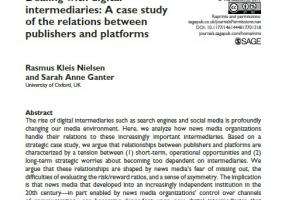Hurricanes and Hashtags: The power dynamics of humanitarian reporting in a digital age
11 Mar 2016
By Shrenik N Rao
Glenda Cooper shared her insights on the power dynamics of reporting a humanitarian crisis in a digital age, and raised several pertinent questions, including: do social media really allow diverse points of view? Having studied the news reportage during the earthquake in Japan (2011), the Hudson plane crash, Oklahoma tornado and Bangkok bomb blasts (2015), from an anthropological lens, she presented insightful observations that can be grouped into three points: 1. Rise of ‘Accidental Journalists’ and Hierarchy of Social Media Sources Social media allow diverse points of view. Users share content such as photographs and videos, in real time, during a humanitarian crisis, when it would otherwise be difficult or almost impossible, to report or reach the place. Using social media, citizens, who are sometimes expatriates, act as journalists and report whatever they can from where they are. There is a rise of what has been termed ‘accidental journalism’. Journalists collect information from these sources, mostly people with access to internet and a mobile phone to report on the crisis. However, journalists who gather information from social media, excessively rely on privileged tweeters. Authority sources receive greater importance. There is less reliance on what Cooper calls ‘below the line commentators’. User Generated Content (UGC) is given less priority. Even when it is used, traditional news organisations sometimes use UGC to edit news stories under their own brand name. Analysis of news reports also suggested that existing interpersonal dynamics are reflected on Twitter. She found evidence of overarching bias in choosing UGC material for live blogs, as most of them tend to be from traditional sources. 2. Invasion of Privacy and Ethical Questions Cooper observes that the use of UGC raises important ethical concerns. Her research, based on the Guardian and the BBC but going wider than that, shows that the majority of sources were not contacted before using their tweets, images or videos. There is an overt use of material without always seeking prior consent. Ethical questions about invasion of privacy also emerge. Many journalists only paid lip service to privacy. Sources were quoted and rapidly contacted, sometimes by over 15 or 20 journalists. After their material was quoted and published, some sources were pursued by online ‘trolls’. Some were afraid that they would be reprimanded by their companies or employers. Many were overwhelmed by the unwanted personal attention and felt that they were being blamed for sharing information. Some of them took back control and deleted their social media accounts. On the other hand, some eyewitnesses and sources were actively trying to correct inaccurate information that was being presented by journalists. 3. Agenda Setting NGOs Cooper’s research also points to increasing concerns about the authenticity of NGO voices. She believes that NGOs are at times acting as gate keepers of information and control the messages rather than give authentic stories of survivors. For example, in Haiti and Zaatari (in Jordan), children were given cameras and asked to take photos of humanitarian camps. In Bangladesh, they sent bloggers to report back on humanitarian disasters. However, NGOs still preferred to film or interview the survivors themselves, rather than let the children or bloggers do it. The seminar highlighted the changing complexity of reporting in times of humanitarian crisis in the digital age and brought to light various editorial decisions and ethical issues needing careful consideration by practising journalists.
Glenda Cooper, lecturer in journalism at City University and author of Humanitarianism, Communications and Change spoke at the Business and Practice of Journalism seminar at Green Templeton College on Wednesday February 20, 2016.




